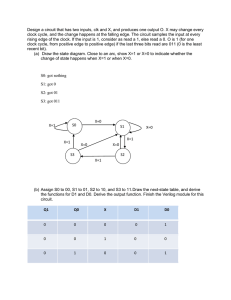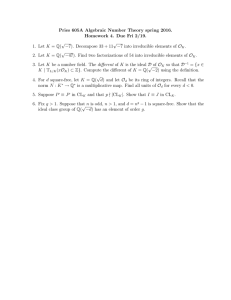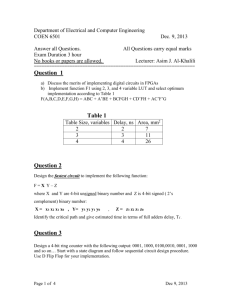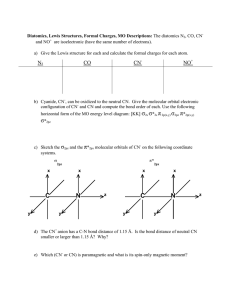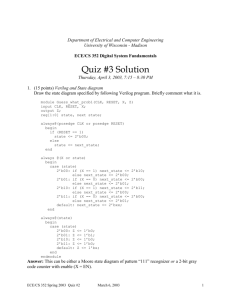MASSACHUSETTS INSTITUTE OF TECHNOLOGY Department of Electrical Engineering and Computer Sciences
advertisement
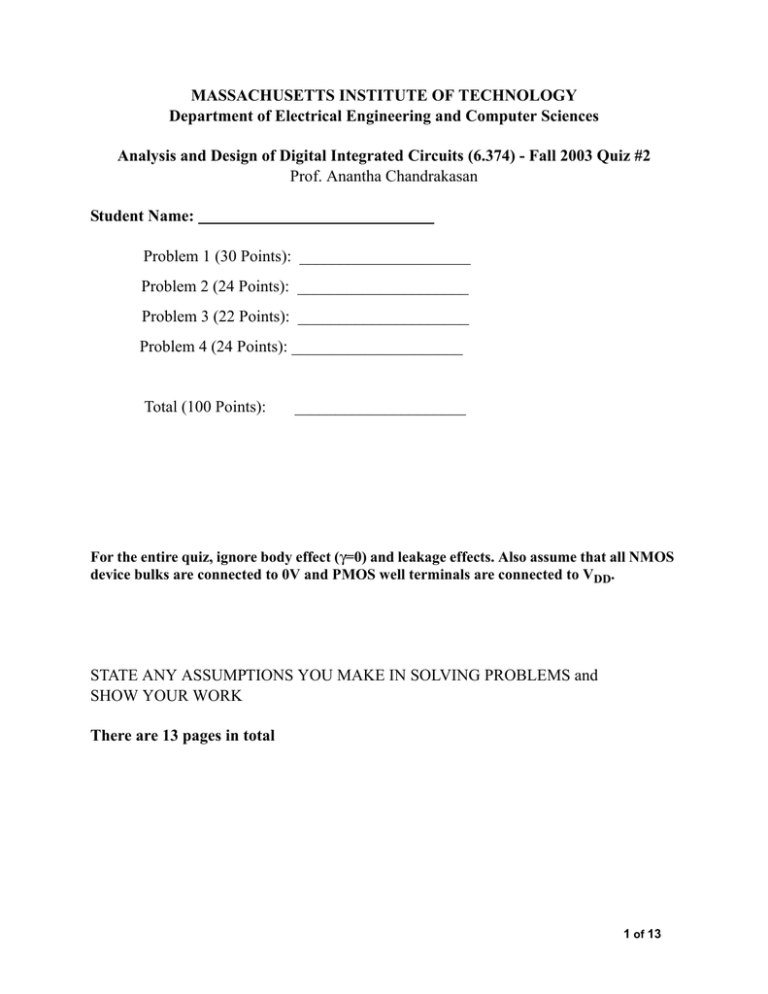
MASSACHUSETTS INSTITUTE OF TECHNOLOGY Department of Electrical Engineering and Computer Sciences Analysis and Design of Digital Integrated Circuits (6.374) - Fall 2003 Quiz #2 Prof. Anantha Chandrakasan Student Name: Problem 1 (30 Points): _____________________ Problem 2 (24 Points): _____________________ Problem 3 (22 Points): _____________________ Problem 4 (24 Points): _____________________ Total (100 Points): _____________________ For the entire quiz, ignore body effect (γ=0) and leakage effects. Also assume that all NMOS device bulks are connected to 0V and PMOS well terminals are connected to VDD. STATE ANY ASSUMPTIONS YOU MAKE IN SOLVING PROBLEMS and SHOW YOUR WORK There are 13 pages in total 1 of 13 Problem 1: Carry Skip Adder: In this problem, we will explore the addition of two numbers based on the Carry Skip (or Carry Bypass) technique. a) Consider the following 16-bit Carry Skip Adder. Assume that the Sum Logic (SL) block for stage i has as inputs Pi, Gi, and Cin,i. Assume the following delays: • Delay to produce the Pi, Gi signals from the Ai, Bi inputs is 1 (i.e., the delay of the PG_L block) • Delay to compute Cout_i from Pi, Gi and Cin,i inputs is 1 (i.e., the delay of the Carry Logic (CL) block) • Delay to compute Si from Cin,i, Pi, Gi being valid is 2 (i.e., the delay of the Sum Logic (SL) block) • Delay for the 2:1 multiplexor is 2 • Delay to compute the group propagate, GPi, is 1 (assume for the entire problem that this delay is independent of the fan-in) Cin,0 PG _L PG _L PG _L CL 0 CL 1 CL 2 CL 3 SL 0 SL 1 SL 2 SL 3 S0 S1 S2 S3 0 1 PG _L PG _L PG _L PG _L CL 4 CL 5 CL 6 CL 7 SL 4 SL 5 SL 6 SL 7 S4 S5 S6 S7 0 1 A8 B8 A9 B9 A10 B10 A11 B11 PG _L PG _L PG _L PG _L CL 8 CL 9 CL 10 CL 11 SL 8 SL 9 SL 10 S10 S8 S9 GP 2= P8P9P10P11 PG _L A4 B4 A5 B5 A6 B6 A7 B7 GP 1= P4P5P6P7 A0 B0 A1 B1 A2 B2 A3 B3 GP 0= P0P1P2P3 Highlight the critical path for this 16-bit adder directly on Figure 1 (4 points) A12 B12 A13 B13 A14B14 A15 B15 PG _L PG _L PG _L PG _L CL 12 CL 13 CL 14 CL 15 SL 11 SL 12 SL 13 SL 14 SL 15 S11 S12 S13 S14 S15 0 1 Cout,15 Figure 1: A 16 bit Carry Skip Adder with a block size M = 4. (b) What is the delay for a 32-bit adder assuming equal block sizes of 4 and making the same assumptions of delay as 1 (a)? (4 points) 2 of 13 (c) Consider an N-bit Carry Skip adder with equal block sizes of M-bits. With the same timing assumptions of 1(a), derive the optimum block length M, for an N-bit adder. (6 points) (d) Consider a transmission gate implementation of a 4-bit Carry-Skip section. Derive the signals S1, S2, and S3 as a function of Pi and Gi. Will this circuit work if Pi = A +B? Explain. (8 points) S1 Cout,3 Cin S2 P0 G2 G1 G0 P1 G3 P2 S3 Figure 2: A transmission gate implementation of a 4-bit Carry Skip section. 3 of 13 (e) Consider the following 32-bit adder variation where the block sizes of each stage are not equal. Highlight the critical path directly on Figure 3. What is the delay of the critical path? (8 points) A0,B0 A1-3,B1-3 A4-8,B4-8 P, G P,G P,G 0 Bits1-3 Bits 4-8 Bits 9-15 0 Bits1-3 Bits 4-8 Bits 9-15 A9-15,B9-15 A16-22,B16-22 A28-30,B28-30 A31,B31 P,G P,G P, G Bits 16-22 Bits 23-27 Bits 28-30 31 Bits 16-22 Bits 23-27 Bits 28-30 31 P,G P,G A23-27,B23-27 Sum Logic Figure 3: A 32-bit Carry Skip Adder with a variable block size. 4 of 13 Problem 2: Sequential Element: Consider the following circuit. Assume that each inverter takes 1 time unit for a low-to-high or high-to-low transition. Assume that it takes 1 time unit for a pull-up path or pull-down path to pull-up or pull-down, respectively. Ignore any leakage effects. Assume VDD >> VT. Also assume that there is no skew between CLK and CLK and assume that the rise/fall times on all signals are zero. VDD D VDD Symbol X I1 I2 I3 SE CLK I4 I5 Q I6 D Q CLK Y D CLK Figure 4: Sequential Element. (a) Complete the timing diagram below. What type of sequential element is the above circuit? Be specific. (8 points) 1 CLK D X Q 5 of 13 (b) What is the setup time, tsu, hold time, thold and propagation delay, tp of this sequential building block relative to the appropriate edge(s)? Explain. (6 points) 6 of 13 (c) Consider the following simple sequential system built using the sequential element in Figure 4. Assuming that there is no skew in distributing the clock, what is the minimum possible clock period for which this sequential system will function? Assume that the primary input In is setup before the appropriate clock edge(s). (6 points) SE1 In D Q CLK SE2 Combinational Logic tlogic (cd) = 2 tlogic = 10 D Q Out CLK Figure 5: Simple Sequential System. (d) What is the maximum positive skew on the clock to SE2 such that the circuit still functions? (4 points) 7 of 13 Problem 3: Sequential Circuit: Consider the following circuit. Assume that each inverter takes 1 time unit for a low-to-high or high-to-low transition. Also assume that it takes 1 time unit for a pull-up path or pull-down path to pull-up or pull-down, respectively. Assume that ratioed circuits are properly sized (i.e., assume that the devices in the cross-coupled inverters are weak and can be overpowered). Assume that the rise/fall times on all signals are zero. I10 I3 Eval QSD I9 VDD I8 END I7 CLK I6 I2 Eval# QSD# I5 VDD VDD CLK I1 I4 D CLK VDD CLK CLK Figure 6: Sequential Circuit. (a) Complete the following timing diagram for QSD, QSD#, END. (8 points) 1 CLK D END QSD QSD# 8 of 13 (b) Assuming that the circuit of Figure 6 directly drives a dynamic DCVSL gate (i.e., differential N-type dynamic logic clocked by CLK), what is the setup time of the circuit in Figure 6 relative to the appropriate clock edge? Explain. (4 points) (c) What is the hold time, thold and propagation delay, tp, of the circuit in Figure 6 relative to the appropriate clock edge? (4 points) 9 of 13 (d) Consider the following sequential implementation which includes both differential dynamic logic and static logic. The circuit below has a major problem. Identify the problem and propose a solution (draw a gate level schematic). (6 points) D CLK Dynamic Out DCVSL Logic Figure 6 gate Out# QSD# Circuit of QSD Static Logic Out_static Positive Edge Triggered Register CLK CLK Figure 7: Sequential System. 10 of 13 Problem 4: Interconnect Issues: For this entire problem assume CI/CL = 5. (CI is the interwire capacitance and CL is the line capacitance to the substrate). An inverter is modeled using resistors and an ideal switch. The switch is connected either to the top resistor or the bottom resistor. (a) Consider the 2-line bus shown in Figure 8. Compute the total energy drawn from the power supply VDD for the transition of (In0, In1) from 01 to 10. (6 points) VDD R R In0 LINE 0 CL CI In1 LINE 1 CL Figure 8: 2-bit bus. 11 of 13 (b) Consider the following modification in which the inverters are replaced by tri-state inverters. When the enable signal En is low, the tri-state does not drive the LINE. In addition, a switch with a small resistance R is added in parallel with CI which is closed when the control signal S = 1. Consider the same transition as 4(a) in which (In0, In1) switches from 01 to 10. However, before the transition happens, the switch is shorted and then opened. Assume that the time period when the switch is closed is long enough for all the transients to settle. Compute the total energy drawn from the power supply VDD. (8 points) VDD R En In0 R In1 En En LINE 0 In0 CL R En In1 S CI S LINE 1 CL Figure 9: Modified driving scheme for a 2-bit bus. 12 of 13 (c) Consider the following input sequence, which represents all the possible transitions for 2 input bus. Transition Sequence: 00J00J01J10J11J00J10J10J01J11J01J01J00J11J11J10J00 What is the difference in energy drawn from the power supply for the above sequence using the approach in 4(b) vs. 4(a). For the scheme in part 4 (b), assume that you may choose on a transition by transition basis if the switch should be closed before the transition happens. If the switch is closed between transitions, assume that the tri-state driver is off during that period. (10 points) 13 of 13

